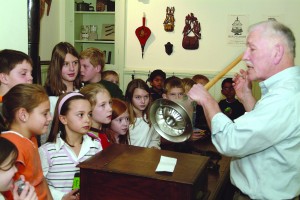When I arrived at the Detroit Historical Society in October 2010, I learned that the only school program offered was a 90-minute tour of the Detroit Historical Museum. Since, like the rest of you, I have been taught that the best educational experiences involve hands-on, interactive learning, I was a little mortified. Moreover, when I shadowed my first school program, my mind started wandering about 45 minutes in. I couldn’t believe third and fourth graders made it through the whole 90 minutes.
So, of course, I instantly res olved to can the program and create more focused and interactive school workshops. I wasn’t surprised by the hesitation from staff and the docents, but I admit that the backlash from teachers caught me off guard. It turns out that teachers LOVE the tour because it hits every single state learning standard they have for local history in one nice package.
olved to can the program and create more focused and interactive school workshops. I wasn’t surprised by the hesitation from staff and the docents, but I admit that the backlash from teachers caught me off guard. It turns out that teachers LOVE the tour because it hits every single state learning standard they have for local history in one nice package.
I was perplexed. I decided to keep the tour, but create some new hands-on workshops as a supplement. They were very successful this school year, but not as much as the tour.
So, what was I going to do? The dreaded guided tour is clearly here to stay.
I resolved to spend this summer creating some tour enhancements. Here’s my process:
- Get the docents involved. I am a very blessed museum educator. Volunteer docents lead all our tours, and they are amazing. Over the years, they have developed tips and tricks to engage the students. So, I arranged for monthly “docent chats.” The first few meetings I had them share their strategies for “classroom management” and tour content. Now I am hosting brainstorming sessions on how to enhance the tour. They have some amazing ideas I would never have considered.
- Get more hands-on resources into the tour. I am putting together some “treasure chests” in different exhibits throughout the museum. They will be locked during regular museum hours, but can be unlocked by docents leading the tours. Inside are reproductions and touchable artifacts that the docents can use to supplement their words. For example, in our exhibit on the fur trade, I’ll have beaver pelts and reproduction French trade goods.
 Develop more opportunities for interaction. Years ago, one of the docents developed a tour activity that has the students act out the automobile assembly line. The students loved pretending to place parts on “cars” (other students) coming down the line. And they learned! I am planning for at least one of these activities in each gallery of the tour.
Develop more opportunities for interaction. Years ago, one of the docents developed a tour activity that has the students act out the automobile assembly line. The students loved pretending to place parts on “cars” (other students) coming down the line. And they learned! I am planning for at least one of these activities in each gallery of the tour.- Train the docents on how to work with different age groups. Our docents do school tours for all grades between K and 12. I am using some great resources (which I’ll talk about in my next blog post) to teach them how to use museum and developmental learning theories to engage with all audiences.
I know I am putting all this effort into a tour that really isn’t broken. But it is important to me that each student has a fun learning experience. I am finding that our docents want that too, and they are eagerly absorbing all these new ideas and information. I’ll let you know at the end of summer how everything turns out.



